Creating a Charming French Courtyard Garden: Inspiration and Ideas for Your Outdoor Space
A French courtyard garden can transform an ordinary outdoor spaces into an enchanting retreat filled with rustic elegance and natural beauty. Far more than simple landscapes, this type of garden represents a carefully crafted approach to outdoor living that combines historical charm with practical design.
Originating from centuries of architectural and horticultural tradition, French courtyard gardens offer a unique blueprint for creating intimate, sophisticated spaces. Whether you have a compact urban balcony or a sprawling backyard, French garden principles can help you craft a captivating outdoor sanctuary.
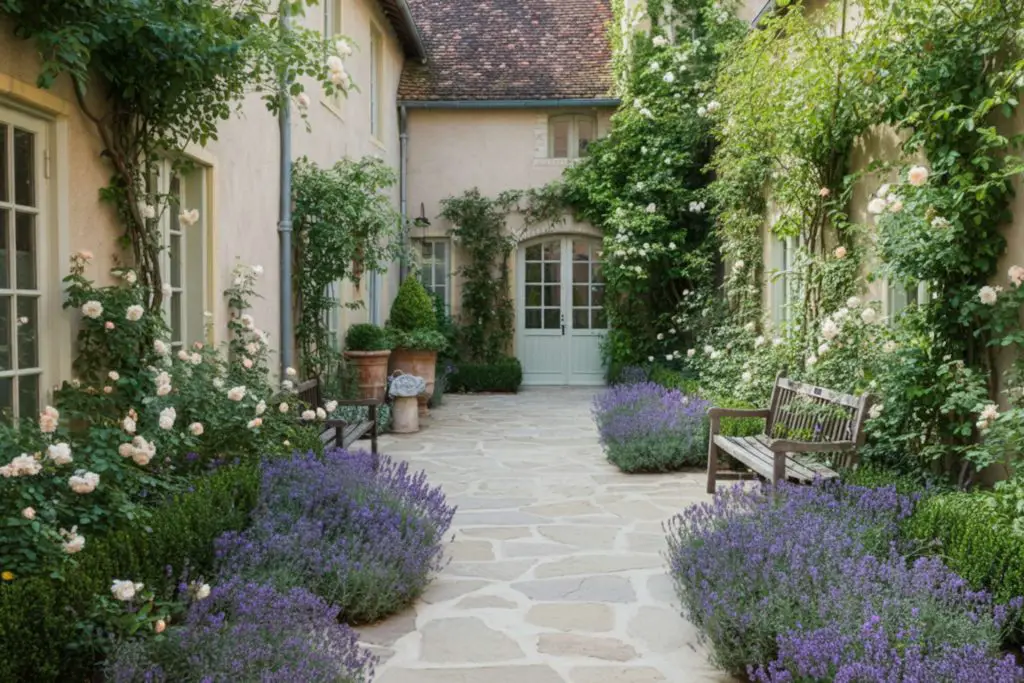
The French Courtyard Garden: A Journey Through History
Roots of a Timeless Design
French garden design traces its roots deep into medieval and Renaissance landscapes. Medieval cloisters first introduced structured outdoor spaces, featuring symmetrical layouts and carefully planned vegetation. Renaissance-era chateaux expanded on these concepts, creating elaborate gardens that balanced geometric precision with natural beauty.
Urban environments like New Orleans’ French Quarter further refined courtyard garden aesthetics. These compact spaces demonstrated how limited square footage could become a verdant, inviting retreat through strategic design and thoughtful plant selection.
Key Elements of French Courtyard Garden Design
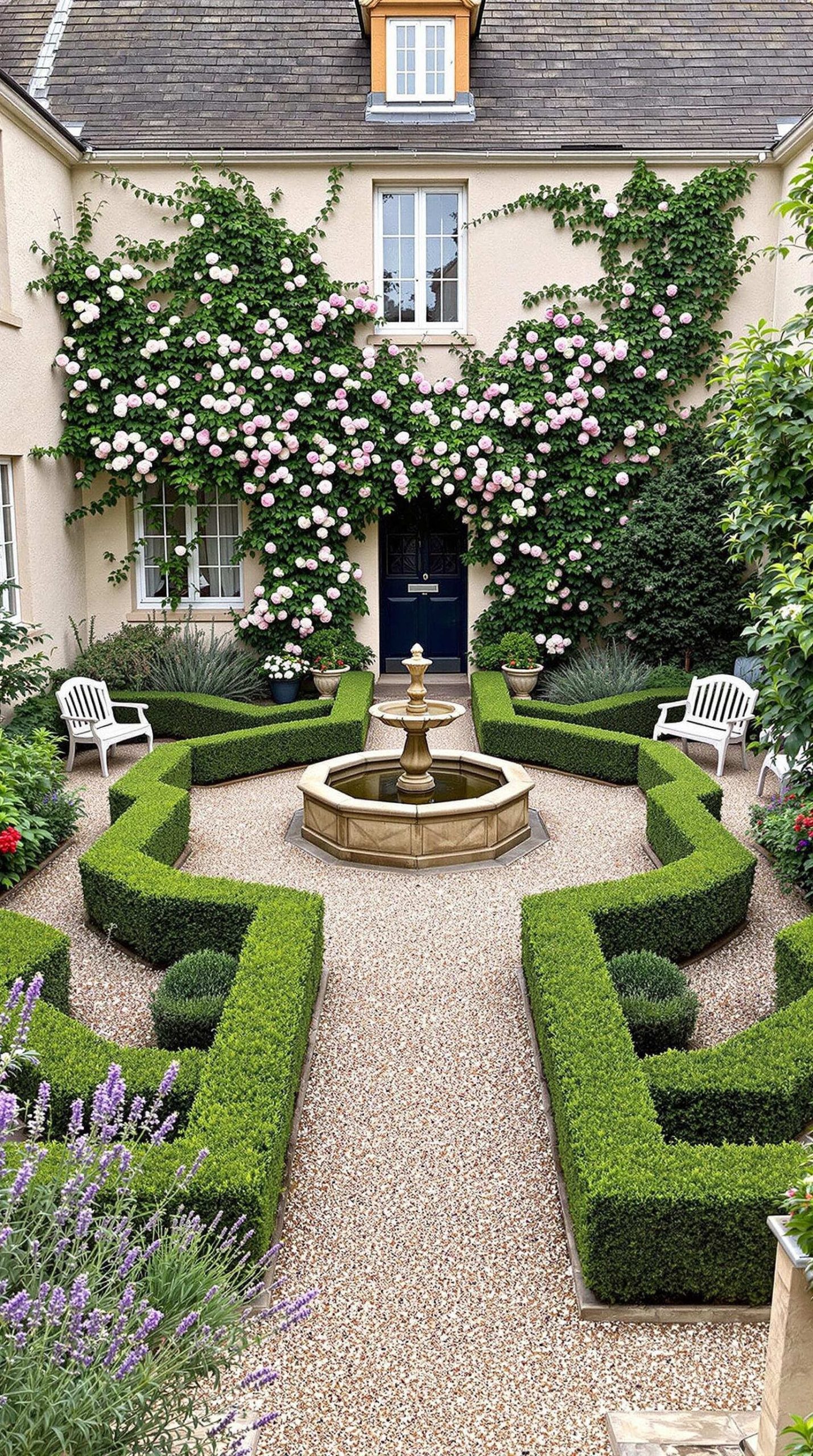
Symmetry: The Foundation of French Garden Aesthetics
Symmetry defines French garden design. Balanced layouts create visual harmony, transforming outdoor spaces into serene environments. Geometric patterns guide the eye, creating a sense of order and tranquility.
Greenery and Foliage: Nature’s Architectural Elements
Strategic plant selection forms the heart of French courtyard gardens. Climbing vines, meticulously trimmed boxwood hedges, and fragrant herbs create layers of texture and interest. Each plant serves both aesthetic and functional purposes, contributing to the garden’s overall composition.
Hardscaping: Rustic Elegance Meets Functional Design
Stone pathways, gravel surfaces, and terracotta elements ground French courtyard gardens in rustic sophistication. These materials provide structure, define spaces, and create visual interest while maintaining a natural, understated elegance.
Water Features: Tranquil Focal Points
Fountains and small basins act as visual anchors in French courtyard gardens. Cascading water introduces movement, sound, and a sense of calm. Strategically placed water features transform gardens into sensory experiences that invite relaxation and contemplation.
Furniture and Decor: Completing the French Garden Narrative
Wrought iron chairs, wooden benches, and vintage accents complete the French courtyard garden’s narrative. These elements invite interaction, creating spaces for dining, reading, or simply enjoying the garden’s ambiance.
Small French Courtyard Garden Ideas: Maximizing Limited Spaces
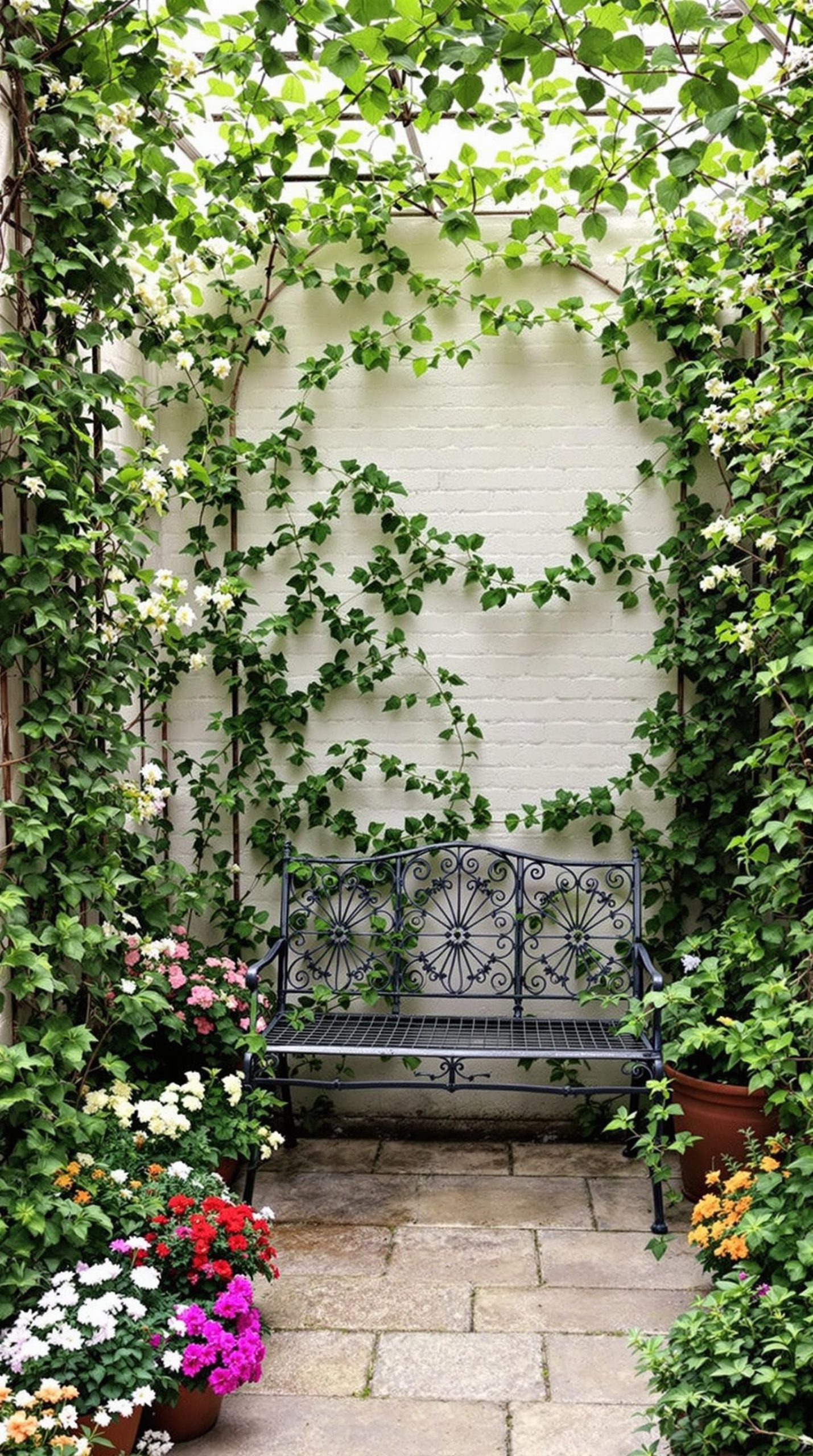
Strategic Space Design for Compact Gardens
Small courtyards present unique opportunities for creative garden design. Vertical gardening techniques transform limited areas into lush, inviting spaces. Walls become living canvases, with trellises, hanging planters, and climbing plants adding depth and greenery.
Multi-Functional Design Strategies
Think beyond traditional garden layouts. Combine seating, dining, and gardening areas to maximize functionality. A small bench nestled among potted herbs or a compact bistro set surrounded by climbing roses can create a multi-purpose outdoor retreat.
French Courtyard Herb Garden: Culinary and Aesthetic Delight
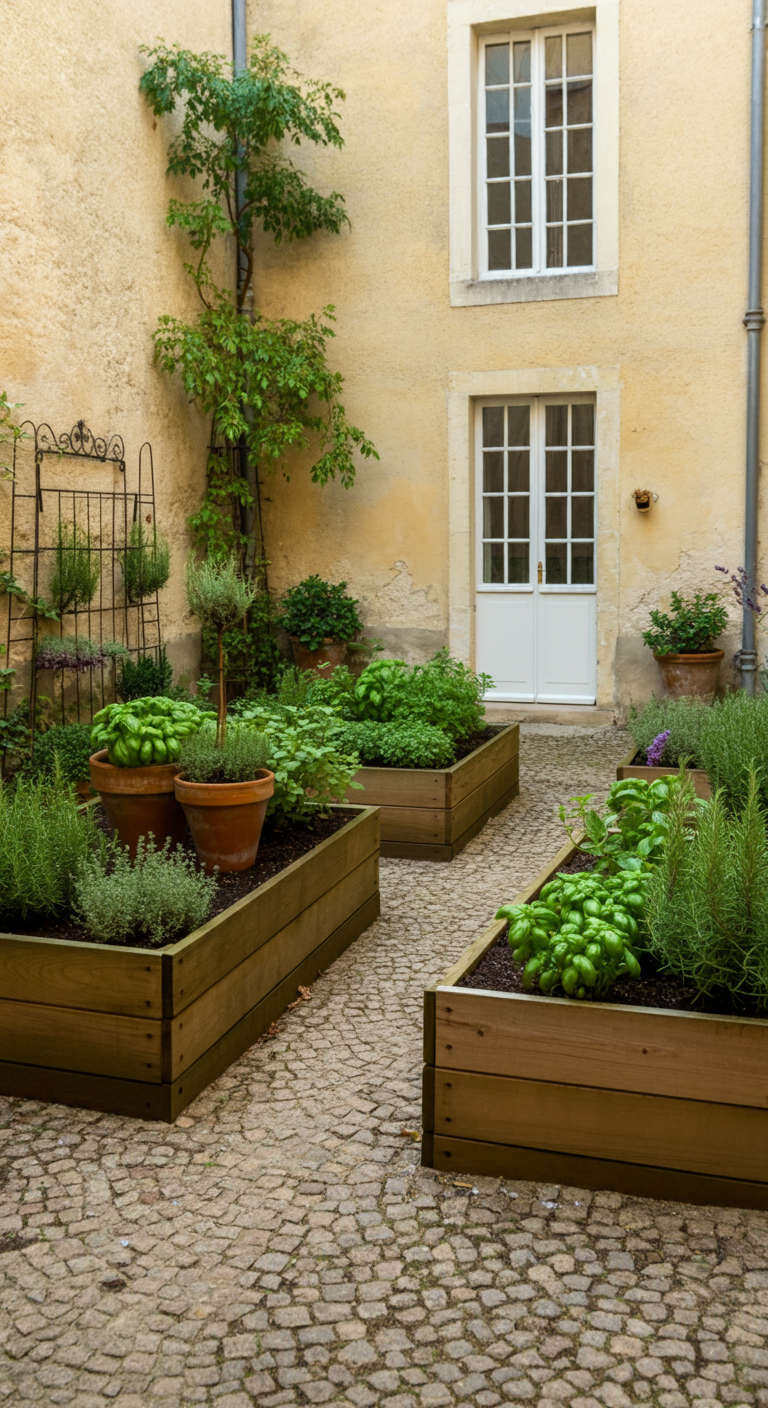
Herb Selection for Authentic French Flavor
Lavender, rosemary, thyme, and basil form the cornerstone of a French-inspired herb garden. These fragrant plants not only provide culinary ingredients but also contribute to the garden’s sensory experience.
Innovative Herb Garden Layouts
Consider multiple planting approaches:
- Raised wooden beds for structured growth
- Terracotta containers for flexible positioning
- In-ground plantings for traditional garden feel
Maintaining Your Herb Garden
Regular pruning keeps herbs productive and prevents overgrowth. Harvest leaves frequently to encourage continued growth and maintain the garden’s neat appearance.
French Courtyard Garden Ideas for Diverse Outdoor Spaces
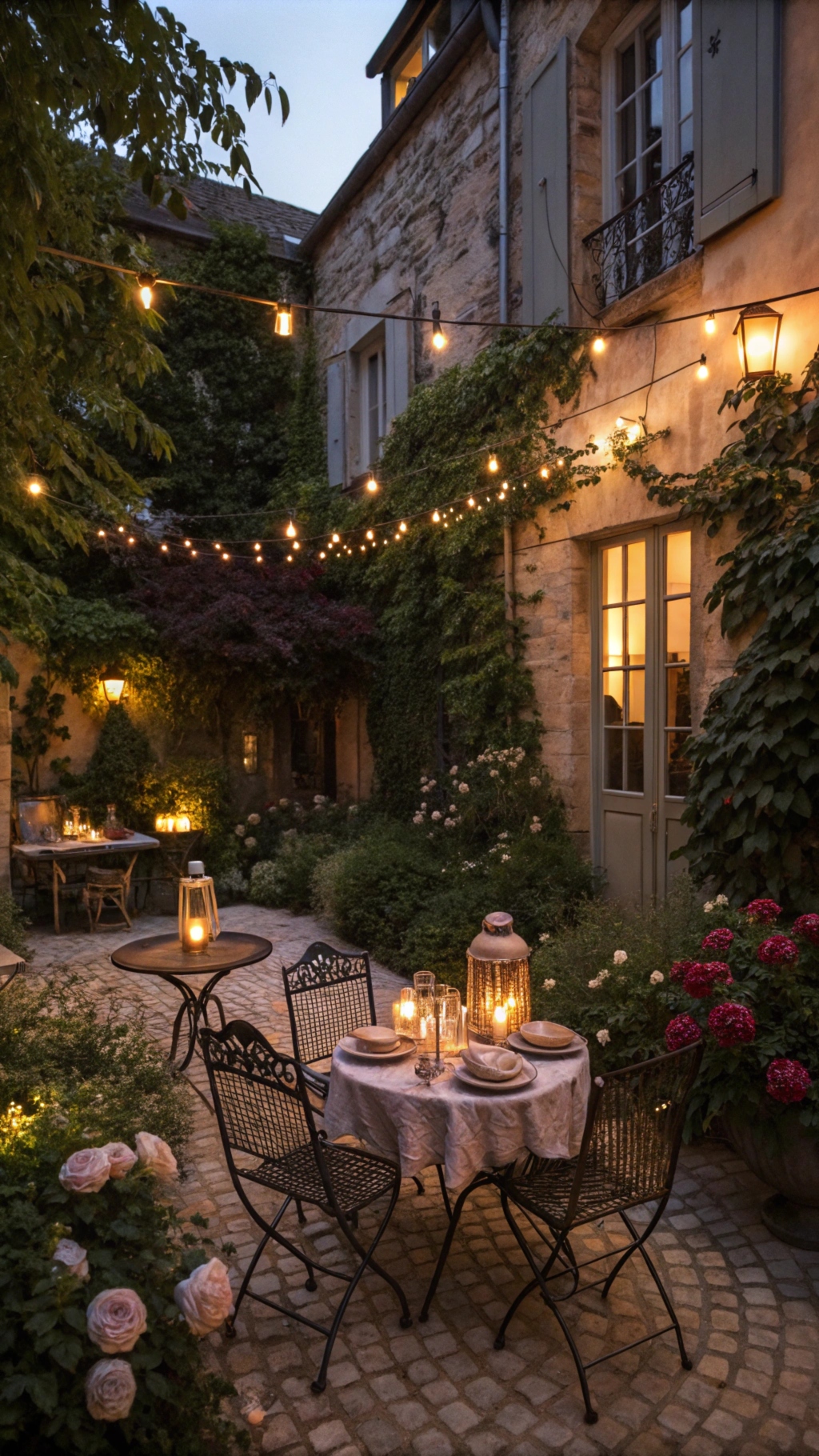
Designing for Different Environments
Whether you have a backyard, front courtyard, or urban balcony, French garden principles can be adapted. Privacy features like lattice screens or strategically placed tall plants create intimate spaces.
Lighting: Extending Garden Enjoyment
Evening ambiance transforms courtyards into magical retreats:
- String lights for soft illumination
- Vintage lanterns for romantic touches
- Candle arrangements for warm, flickering light
Seasonal Garden Considerations
Plan your garden to maintain beauty year-round:
- Spring: Focus on bulb plantings and fresh growth
- Summer: Highlight flowering plants and herb production
- Fall: Introduce warm-toned plants and decorative elements
- Winter: Create structure with evergreen plants and hardscaping
Pea Gravel: The Quintessential French Courtyard Surface
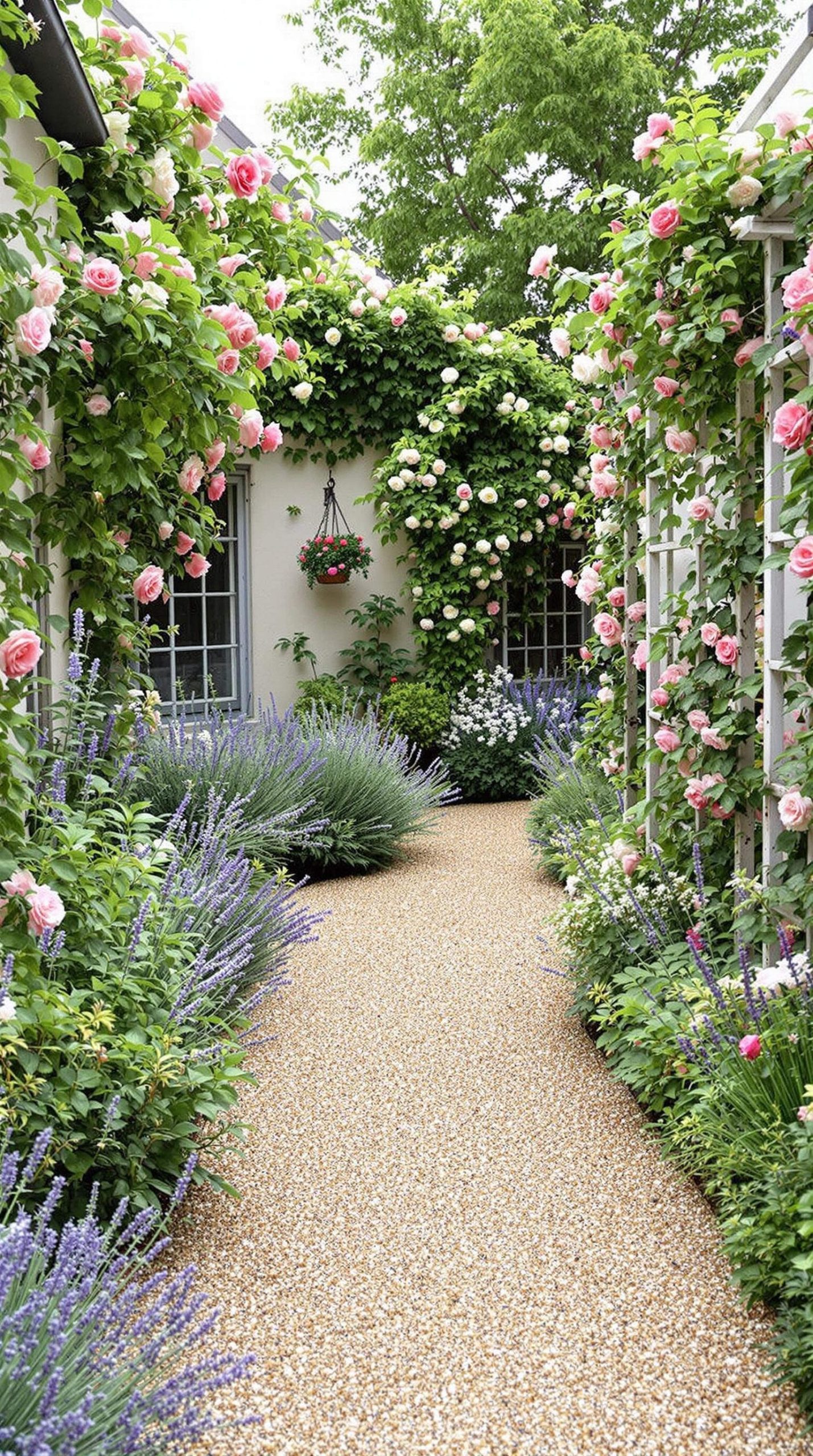
Creating Rustic Charm with Pea Gravel
Pea gravel transforms courtyard spaces with its distinctive texture and natural appeal. Small, rounded stones provide a soft crunch underfoot, instantly evoking the charm of French countryside gardens.
Versatile Applications
Strategically use pea gravel in multiple garden areas:
- Pathway designs
- Patio foundations
- Garden bed borders
- Seating area foundations
Maintenance and Design Tips
Proper installation ensures long-lasting beauty:
- Use landscaping fabric underneath to prevent weeds
- Maintain consistent depth of 2-3 inches
- Edge with stone or metal barriers
- Rake periodically to keep surface even
French Quarter Courtyard Garden: Urban Inspiration

Capturing New Orleans’ Unique Garden Aesthetic
French Quarter courtyards represent a perfect blend of architectural elegance and lush greenery. Wrought iron gates, dense vegetation, and intimate seating areas define this distinctive style.
Key Design Elements
Recreate French Quarter magic with:
- Ornate wrought iron details
- Dense, layered plant selections
- Narrow, deep garden spaces
- Intimate seating arrangements
- Vertical gardening techniques
Case Study Inspirations
Successful French Quarter-inspired gardens typically feature:
- Walls covered in climbing jasmine
- Compact water features
- Mixture of potted and ground-planted greenery
- Vintage architectural elements
Cottage-Style French Courtyard Garden: Soft and Inviting
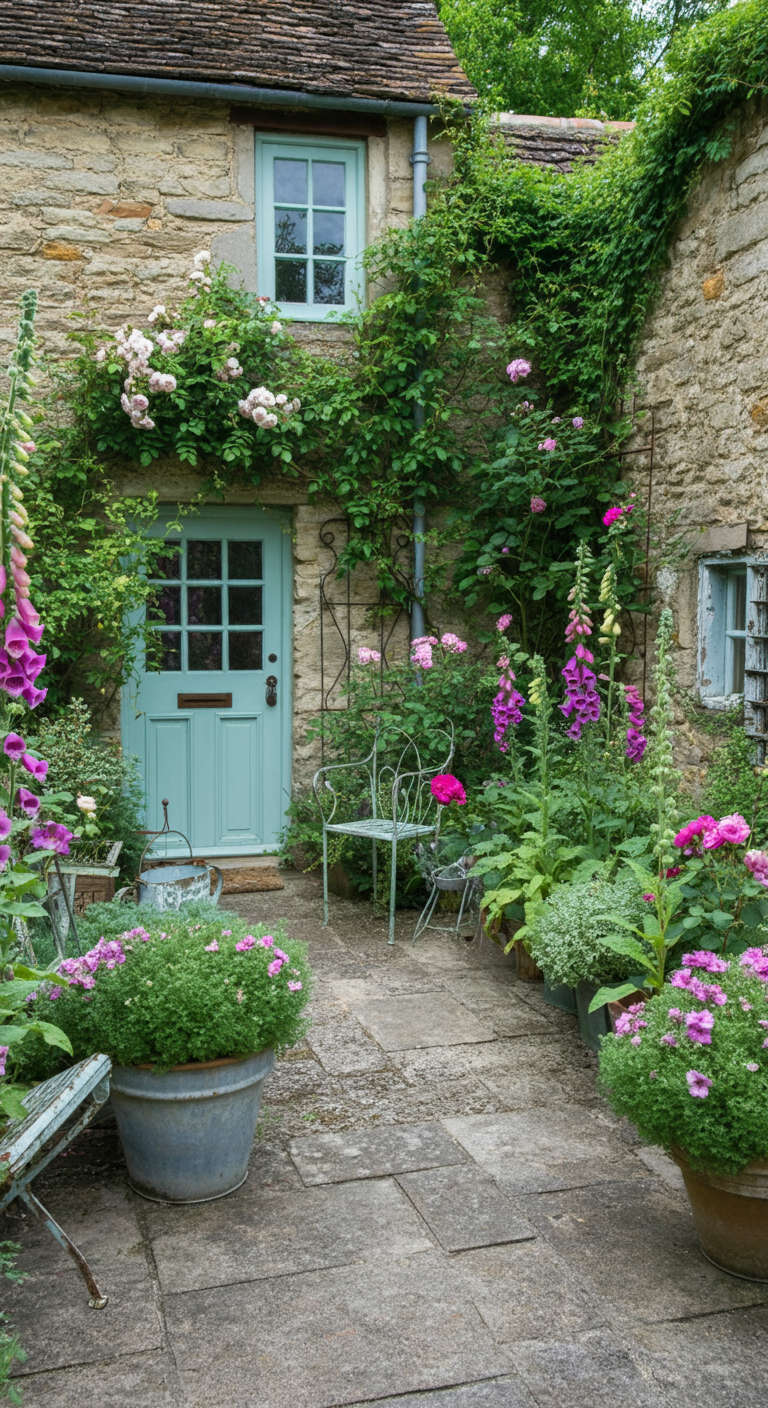
Blending Country Charm with Garden Romance
Cottage-style gardens introduce softness to traditional French garden design. Colorful flowers, wildflower plantings, and informal arrangements create a welcoming, relaxed atmosphere.
Design Strategies
Create a cottage-inspired courtyard by:
- Mixing flower varieties
- Using soft color palettes
- Incorporating vintage garden accessories
- Allowing plants to grow more naturally
Plant Selection Recommendations
Ideal cottage-style plants include:
- Lavender
- Rose varieties
- Foxgloves
- Delphinium
- Hollyhocks
Cottage gardens thrive on imperfection, celebrating natural growth and abundant plant life. Embrace a slightly wild approach that feels both intentional and spontaneous.
Small Courtyard Ideas: Crafting a Garden Nook
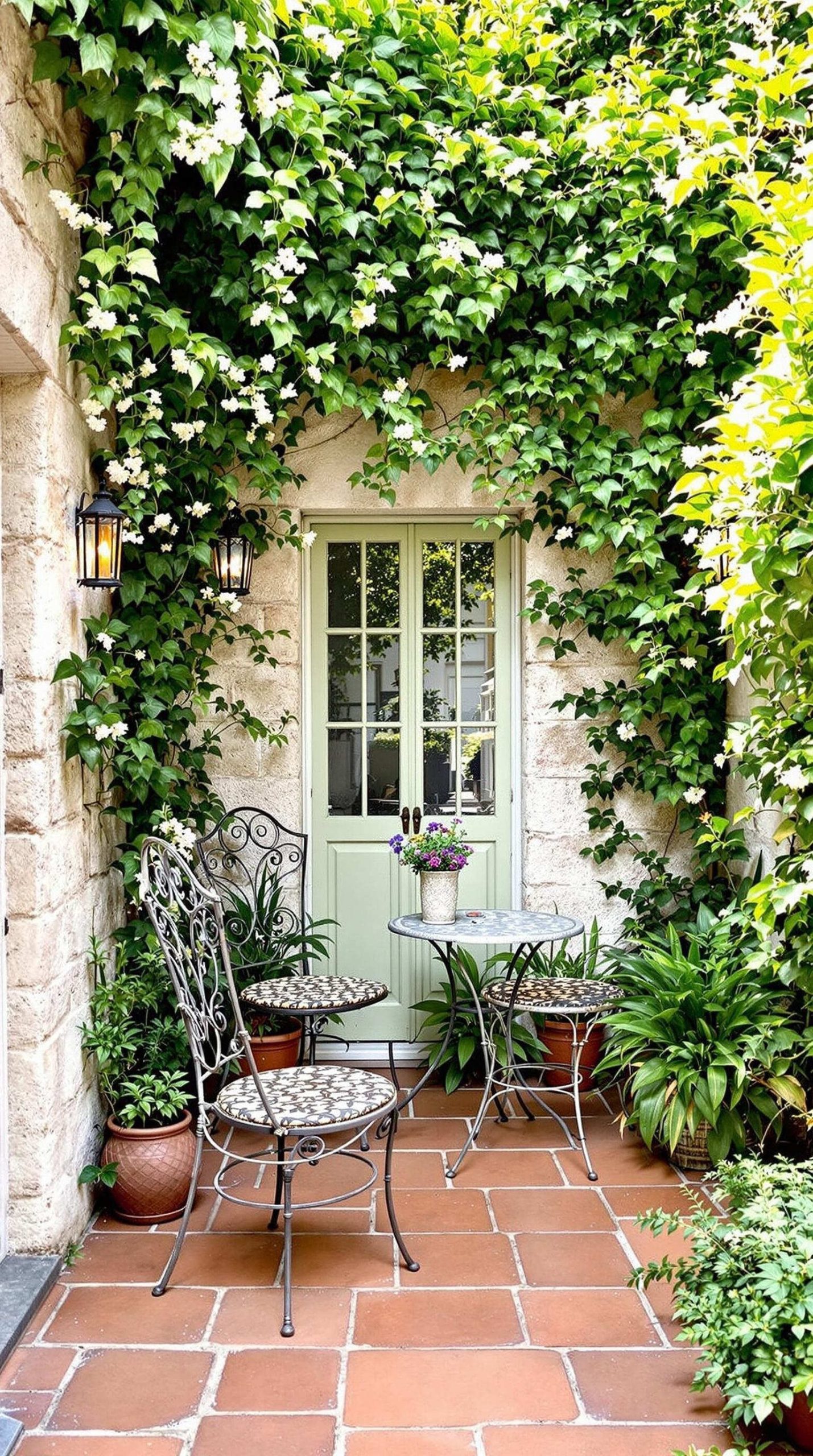
Designing Intimate Outdoor Retreats
Garden nooks transform compact spaces into personal sanctuaries. Even the smallest courtyard can become a transformative outdoor room with strategic design and carefully chosen elements.
Furniture and Comfort Strategies
Maximize limited square footage with:
- Compact bistro sets
- Hanging chairs
- Slim-profile benches
- Foldable furniture options
Creating Vertical Interest
Leverage wall spaces and height:
- Wall-mounted planters
- Vertical gardening systems
- Hanging baskets
- Trellises with climbing plants
Maintenance and Care: Keeping Your French Courtyard Garden Thriving
Seasonal Garden Management
Protect and nurture your garden through changing seasons:
- Spring: Prune winter-damaged plants
- Summer: Regular watering and pest control
- Fall: Prepare plants for dormant period
- Winter: Protect sensitive vegetation
Plant Care Essentials
Maintain healthy garden environments:
- Consistent watering schedules
- Proper pruning techniques
- Organic pest management
- Soil nutrition monitoring
Hardscaping Preservation
Protect garden infrastructure:
- Clean gravel pathways
- Seal stone surfaces
- Protect wooden elements
- Maintain metal furniture
Additional Concepts to Enhance Your French Courtyard Garden
Color Palette: Painting with Natural Hues
French garden color palettes transform outdoor spaces into living canvases, drawing inspiration from the French countryside’s natural spectrum. Understanding color relationships becomes an art form in garden design.
Soft Pastel Foundations
Primary color families for French courtyard gardens include:
- Lavender Purple: Soft, muted tones ranging from pale lilac to deep aubergine
- Sage Green: Understated green hues from olive to soft mint
- Terracotta: Warm earth tones connecting garden to architectural elements
- Cream and Ivory: Neutral backdrops that highlight plant textures
Color Composition Techniques
Strategic color placement creates visual harmony:
- Use complementary colors sparingly
- Group similar color families
- Create depth through color gradients
- Allow green foliage to serve as primary backdrop
Texture and Layering: A Sensory Garden Experience
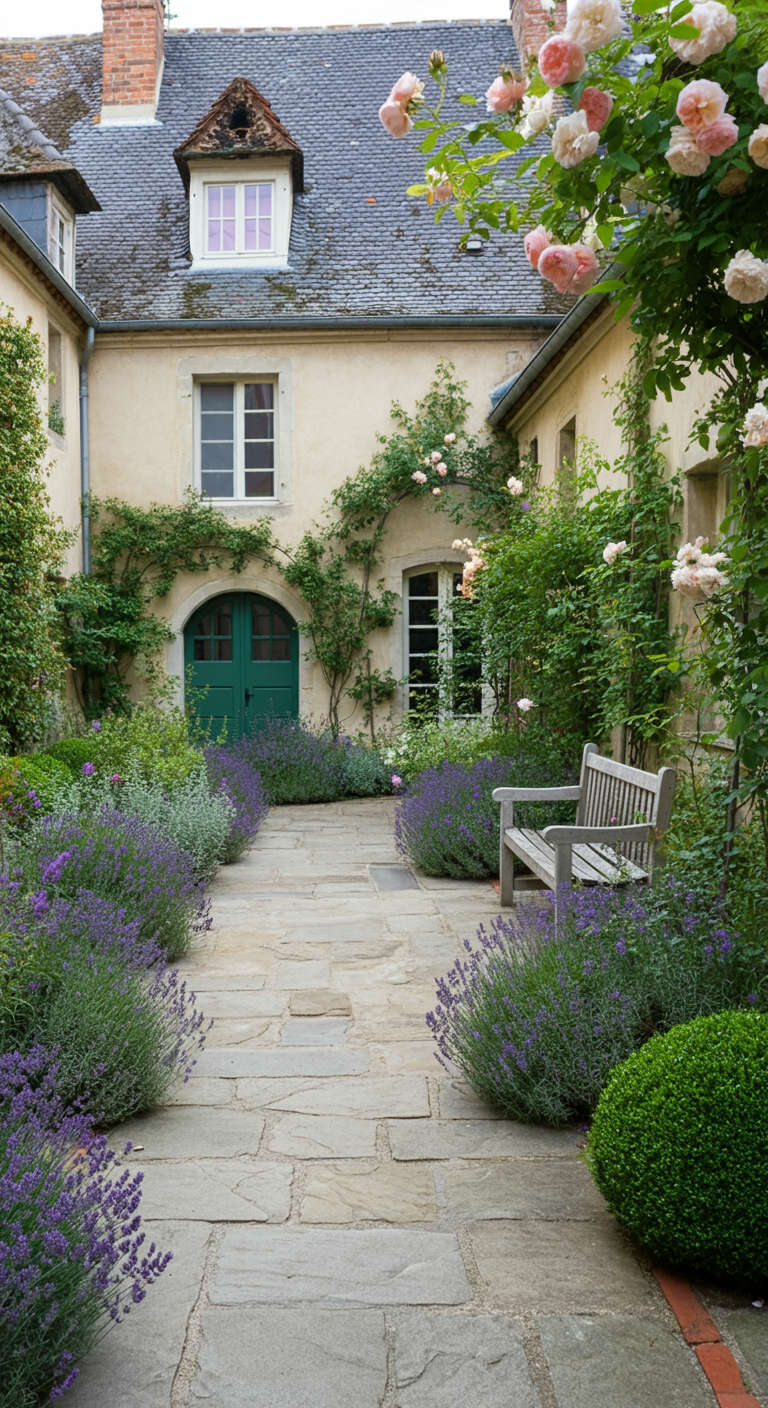
Texture transforms gardens from visual displays to immersive experiences. Thoughtful material combinations engage multiple senses, creating depth and intrigue.
Material Contrast Strategies
Layering techniques for sensory richness:
- Smooth Elements
- Polished stone pathways
- Glazed ceramic planters
- Sleek metal garden accessories
- Rough Textures
- Weathered wooden benches
- Unfinished stone walls
- Bark-covered garden borders
- Soft Botanical Textures
- Feathery ornamental grasses
- Velvety lamb’s ear leaves
- Delicate climbing rose tendrils
Sensory Interaction Design
Garden texture considerations:
- Create walking paths with varied surface materials
- Mix plant heights and leaf shapes
- Incorporate touchable plant varieties
- Use wind-responsive elements like ornamental grasses
Scented Garden Design: Aromatic Outdoor Experiences
Fragrance transforms gardens from visual spaces to immersive sensory environments. Strategic plant selection creates olfactory journeys that change throughout seasons.
Classic French Aromatic Plants
Key fragrant selections:
- Roses: Multiple varieties with distinct scent profiles
- Damask roses: Intense, complex fragrance
- Bourbon roses: Rich, spicy undertones
- Provence roses: Light, sweet aromatics
- Lavender: Quintessential French garden herb
- English lavender: Strong, clean scent
- French lavender: Softer, more delicate fragrance
- Ideal for border plantings and sensory pathways
- Jasmine: Nighttime fragrance specialist
- Star jasmine: Delicate, sweet evening scent
- Winter jasmine: Subtle, fresh aromatics
- Perfect for vertical garden elements
Fragrance Layering Techniques
Design strategies for aromatic gardens:
- Create scent progression zones
- Mix long-blooming fragrant plants
- Consider bloom times and seasonal changes
- Position scented plants near seating areas
- Use wind patterns to distribute fragrances
Companion Planting for Fragrance:
- Combine herbs with flowering plants
- Group plants with complementary scent profiles
- Create micro-climate scent experiences
Sustainable Garden Practices
Implement eco-friendly design strategies:
- Drought-tolerant plant selections
- Water-efficient irrigation systems
- Native plant integration
- Organic gardening techniques
DIY Garden Enhancement Projects
Simple projects to personalize your space:
- Handcrafted plant markers
- Repurposed garden furniture
- Mosaic stepping stones
- Painted terracotta pot collections
Photography Tips for Capturing Your Garden
Capture the essence of your French courtyard garden:
- Morning light for soft shadows
- Macro shots of herb details
- Wide angles showing garden layout
- Seasonal progression documentation
Final Garden Photography Locations
Best spots to photograph your garden:
- Seating area perspectives
- Water feature reflections
- Plant transition zones
- Architectural garden intersections
Final Thoughts: Personalizing Your French Garden Sanctuary
Embracing Individual Garden Expression
French garden design offers a framework, not a strict mandate. Your courtyard should reflect personal style, comfort, and connection to nature.
Creating a Personal Retreat
Focus on elements that bring joy:
- Meaningful plant selections
- Comfortable seating arrangements
- Lighting that enhances mood
- Decorative touches that speak to your aesthetic
A French courtyard garden represents more than landscaping—it’s an invitation to slow down, appreciate beauty, and create a personal outdoor sanctuary.
